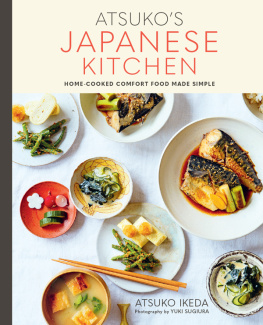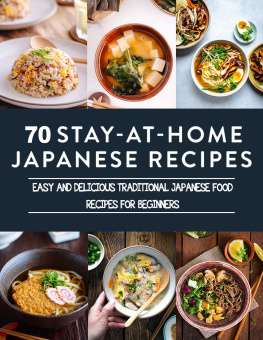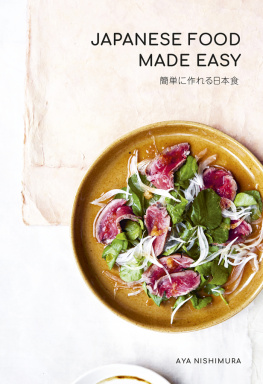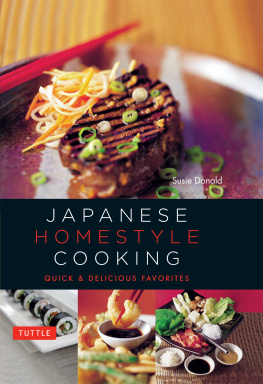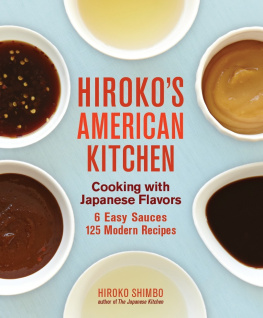the Zen Kitchen
Those who have eaten noxious food or drunk alcohol may not enter the temple Engraved on stone pillars outside Zen temple gates
the Zen Kitchen
ADAM LIAWwith Asami Fujitsuka
contents
INTRODUCTION9A Year of Eating10Japanese Ingredients18chapter onepickles, stocks and seasoningsAsazuke pickles25Nukazuke pickles26Brown vinegar pickles30Boosted soy sauce36Teriyaki glaze36Salmon flake37No. 1 stock38Bonito stock38All-purpose chicken dashi39chapter twojapanese breakfastsHot-spring eggs42Bacon and spinach stir-fry45Grandmas rice porridge46Full Japanese breakfast51Brown butter, salmon flake and shiitake toast52Dashi eggs on rice55Wholemeal hotcakes56chapter threerice and noodlesWholegrain rice 60Salmon flake rice balls63Sushi sandwiches64Salmon ochazuke69Summer ramen70Tuna tartare donburi73Hand-rolled family sushi76Salmon sushi balls79Nabeyaki chicken and egg udon80chapter foursoup and nabemonoChilled corn and soy milk soup85Classic clam miso soup88Cherry Tomato miso soup89Tofu and mushroom miso soup90Potato and onion miso soup91Hapuka and shiitake clear soup92Chicken and noodle clear soup95Shabu-shabu98Sukiyaki of beef and Asian greens101Soy milk nabe102Tantan chicken nabe105chapter fivejapanese saladsOnion and garlic vinaigrette110Ponzu110Sesame sauce111Wa-fu dressing112Miso dressing112Ginger dressing113Butashabu salad114
Sashimi salad117Japanese garden salad118Chicken, daikon and cucumber salad123'Spring rain' noodle salad with spinach and shiitake124Carrot salad127chapter sixfishShioyaki (salt-grilling)130Misozuke (miso-marinating)135Nizakana (soy-simmering)138Snapper chirimushi143Barbarian salmon146Salmon ankake149Kingfish and daikon152Braised tuna155chapter sevenmeatSteamed pork with sesame sauce158Chicken and prawn chawanmushi161Wagyu with autumn-leaf radish162Chicken negishio167Miso-cured pork168Teriyaki pork and mushroom rolls171Chicken and tofu meatballs172Chikuzen-ni175chapter eightmainly vegetablesSalted cabbage178Hiyashi tomato181Quick soy-steeped spinach 182Soy-flavoured eggs186Cucumber and wakame187Cold cucumbers with snapper miso189Eggplant with capsicum and miso 190Egg, beansprouts and garlic chives195Eggplant nibitashi198Beans in black sesame199Corn with mayonnaise, bonito and nori199Agedashi tofu200Oden205Chilled tofu with Tomato and ponzu206Carrot and lotus root kinpira209Vegetable skewers with miso-dare210Simmered new potatoes213chapter ninesemi-sweetsOkinawan salted shortbread216Fruit jellies219Fruit parfaits220Green tea roll cake225Pumpkin pudding226Fruit sandwiches229Mille-crepe230Rabbit apples233 index236
For our daughter Anna, who made writing this book easy in her own way.
INTRODUCTION The Japanese approach to food is one we might all admire. Simultaneously respectful, appreciative, enthusiastic and practical, its an approach that has produced one of the worlds greatest cuisines and one that is simple to cook, healthy, delicious and hugely varied. Its done this not through some happy accident that saw good produce meet good cooks, but through centuries of forging a strong connection between food and people. To understand Japanese food is not just to know how to cook it, but it is also to understand what it represents.In Japan, food is something used to celebrate, to educate. Its more than just a part of Japanese culture, it is a totality of Japanese culture presented in its most tangible form. This is my fifth cookbook, and while my earlier books have all included many Japanese recipes, this is the first book Ive written solely devoted to Japanese cuisine. In writing it, I wrestled with the best way to communicate what Japanese food truly is, not just in the mechanics of how to make it, but to put it in context of the culture its entwined with so completely. Ultimately I decided that the best way to do that was the way most Japanese people learn about their own cuisine, which is not through the rote learning of recipes and measurements, but through the stories and idioms that tie culture and cooking together, for truly neither could exist without the other. We can learn as much about food from a story or proverb as we can from a measurement or method. Often more.In 2016 the Japanese government appointed me to serve as an official Goodwill Ambassador for Japanese Cuisine. It was the first time that honour had been bestowed outside Japan, and one I was humbled to receive. The responsibility in this role, however, is a simple one, as within Japanese cuisine there is much goodwill to share. Throughout this book, through each recipe, picture, instruction and sentence, I will be guiding you through how to cook, eat and understand Japanese food. The kind of food my family, and thousands like it, eat every day. The kind of food that has made Japan one of the longest-lived, healthiest, and most food-loving nations on Earth.Itadakimasu.
A Year of Eating
Japan is a country of four seasons, and although that simple fact may seem common enough, its what Japan does with those seasons that is truly special. I have never experienced another country where the seasons have such a profound impact. Its not just about the weather that the seasons bring, although that certainly changes as well, but in the way they affect seemingly every aspect of daily life. In terms of food we tend to think of seasonality as relating mostly to the availability of ingredients, and while thats certainly important, in Japan seasonality goes much deeper than just whats in the shops. An understanding of seasonal ingredients is common knowledge. The youngest child will have a favourite fish for each of spring, summer, autumn and winter. The dishes themselves will also be different in their style, composition and even seasoning. Summer foods will be slightly more salty to encourage drinking, and vinegared dishes will have more piquancy to stimulate appetite. As the season moves to autumn, similar dishes will take on slightly more savoury characteristics in place of the sourness. Winter and spring dishes are less heavily salted than those served in summer. From season to season, even the plates and bowls used for serving food will change, as they are chosen to communicate an impression of each season through colour, shape, material or motif.
The Importance of Quality
Every town or region in Japan has a specialty an ingredient or dish that they feel they grow or cook better than anywhere else on Earth. Tuna from Oma, peaches from Yamanashi, rice from Niigata or ramen from Fukuoka it sometimes seems like Japan is a nation where everyone seems to be striving for perfection in one field or another.Heavily marbled wagyu beef from areas like Matsuzaka, Hida and Kobe are peerless in flavour and texture. The same could be said for the kurobuta pork from Kagoshima and the delicious Agu breed from Japans most pork-loving region, Okinawa. The buttery flavour and texture of Nagoya cochin chicken would rival the finest Bresse birds from France.The thing about quality is you have to decide what it means to you: increased satisfaction or increased desire? When food is high quality and delicious we dont need to eat as much to be satisfied, although we may want to eat more. To push past contentment for the sheer sport of it seems indulgent at best, and obscene at its worst.The appreciation of food is not an ever-increasing scale. Being satisfied with one portion of food does not mean well be twice as satisfied with two.A rich piece of wagyu beef is an exquisite delicacy at 120 grams, but eat a 350g steak by yourself and you might wish you hadnt. Japanese food prizes quality over quantity, and that is fundamental to its enjoyment.
10The Zen Kitchen
A Culture of Food and Health
For an ancient cuisine, the Japanese diet addresses many of the challenges that affect how we eat today. Its fast to prepare, healthy, created simply from very few ingredients, and interweaves culture and food in a way that gives greater meaning to each meal beyond just a fuel to keep us going, a tool to quiet the kids, or a quick-fix to a flatter summer stomach.Its hard to argue with one of the healthiest cuisines in the world, and one that has made the Japanese among the longest-lived people on the planet. The Japanese diet embodies many of the points that modern science asks of us in order to eat well. It relies less on red meat than most Western diets, focusing instead on fish and vegetables. It contains fermented foods for digestive health through simple pickles such as Nukazuke (page 26), which are eaten with almost every meal. Rice, although central to the cuisine, is served as a separate element to other dishes, meaning that it is very easy to reduce the amount of refined carbohydrates eaten with your meal, as many Japanese people do these days. Wholegrain rice mixes like the one on page 60 are also hugely popular, boosting the fibre of a bowl of rice as well as providing a delicious flavour.One of the most attractive and reasonable aspects of the Japanese diet is its moderation. Although vegetables form the bulk of the diet, vegetarianism and veganism is relatively uncommon. While sweets are a much-loved treat and sugar is a necessary seasoning, they are rightly considered only parts of a much broader cuisine. The Japanese diet doesnt rely on restrictive exclusions to communicate a message of good health. Good health is inherent to the cuisine. It is a true love of food, wary of the trappings of gluttony or breathless excess.If you were to design a perfect diet based on what modern science tells us today, it might look a lot like the way Japan has been eating for centuries. But the appeal of Japanese food goes far further than the clinical sterility of science.Stories of food and health and their role in a long and happy life are woven through lore and culture so that the lessons of the kitchen teach Japanese children not just how to cook and eat, but how to live well. This kind of education is so important, as it affects everything from saving a few minutes each day through efficient kitchen technique, to a lifetime of healthy eating thats also enjoyable, convivial and shared with those you love.This book isnt a health or diet book. Yet Japanese cuisine has had health at its core long before health had any connections to being skinny. You might well look at Japanese cuisine as a manual for living. It touches every aspect of life relationships, money, politics, manners and, of course, health is a part of it.When you cook the dishes from this book, try to look beyond just the recipe, as each one is a part of a bigger cultural picture. A piece of grilled fish can be just a quick dinner, but it can also be an act of kindness, a philosophy of health, a lesson in patience, a chance to share a story, and a window into another way of thinking.
Next page



